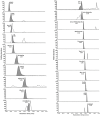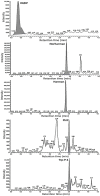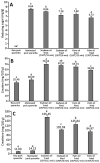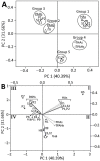Analysis of Polycyclic Aromatic Hydrocarbons via GC-MS/MS and Heterocyclic Amines via UPLC-MS/MS in Crispy Pork Spareribs for Studying Their Formation during Frying
- PMID: 38254486
- PMCID: PMC10814522
- DOI: 10.3390/foods13020185
Analysis of Polycyclic Aromatic Hydrocarbons via GC-MS/MS and Heterocyclic Amines via UPLC-MS/MS in Crispy Pork Spareribs for Studying Their Formation during Frying
Abstract
This study aims to explore the effects of frying conditions on the formation of HAs and PAHs in crispy pork spareribs, a popular meat commodity sold on Taiwan's market. Raw pork spareribs were marinated, coated with sweet potato powder, and fried in soybean oil and palm oil at 190 °C/6 min or 150 °C/12 min, followed by an analysis of HAs and PAHs via QuEChERS coupled with UPLC-MS/MS and GC-MS/MS, respectively. Both HAs and PAHs in pork spareribs during frying followed a temperature- and time-dependent rise. A total of 7 HAs (20.34-25.97 μg/kg) and 12 PAHs (67.69-85.10 μg/kg) were detected in pork spareribs fried in soybean oil and palm oil at 150 °C/12 min or 190 °C/6 min, with palm oil producing a higher level of total HAs and a lower level of total PAHs than soybean oil. The content changes of amino acid, reducing sugar, and creatinine played a vital role in affecting HA formation, while the degree of oil unsaturation and the contents of precursors including benzaldehyde, 2-cyclohexene-1-one, and trans,trans-2,4-decadienal showed a crucial role in affecting PAH formation. The principal component analysis revealed that HAs and PAHs were formed by different mechanisms, with the latter being more liable to formation in pork spareribs during frying, while the two-factorial analysis indicated that the interaction between oil type and frying condition was insignificant for HAs and PAHs generated in crispy pork spareribs. Both CcdP (22.67-32.78 μg/kg) and Pyr (16.70-22.36 μg/kg) dominated in PAH formation, while Harman (14.46-17.91 μg/kg) and Norharman (3.41-4.55 μg/kg) dominated in HA formation in crispy pork spareribs during frying. The outcome of this study forms a basis for learning both the variety and content of HAs and PAHs generated during the frying of pork spareribs and the optimum frying condition to minimize their formation.
Keywords: GC-MS/MS; QuEChERS; UPLC-MS/MS; crispy pork spareribs; frying; heterocyclic amines (HAs); polycyclic aromatic hydrocarbons (PAHs).
Conflict of interest statement
The authors declare no conflicts of interest.
Figures








References
-
- IARC . IARC Monographs on the Evaluation of Carcinogenic Risks to Humans. Volume 114. IARC; Lyon, France: 2018. [(accessed on 15 November 2023)]. Red meat and processed meat; pp. 1–506. Available online: https://www.ncbi.nlm.nih.gov/books/n/iarcmono114/pdf/
-
- IARC . IARC Monographs on the Evaluation of Carcinogenic Risks to Humans. Volume 92. IARC; Lyon, France: 2010. [(accessed on 17 October 2023)]. Some non-heterocyclic polycyclic aromatic hydrocarbons and some related exposures; pp. 1–853. Available online: https://www.ncbi.nlm.nih.gov/books/n/iarcmono92/pdf/ - PMC - PubMed
-
- IARC . IARC Monographs on the Evaluation of Carcinogenic Risks to Humans. Volume 56. IARC; Lyon, France: 1993. [(accessed on 15 November 2023)]. Some naturally occurring substances: Food items and constituents, heterocyclic aromatic amines and mycotoxins; pp. 1–609. Available online: https://www.ncbi.nlm.nih.gov/books/n/iarcmono056/pdf/
Grants and funding
LinkOut - more resources
Full Text Sources
Miscellaneous

